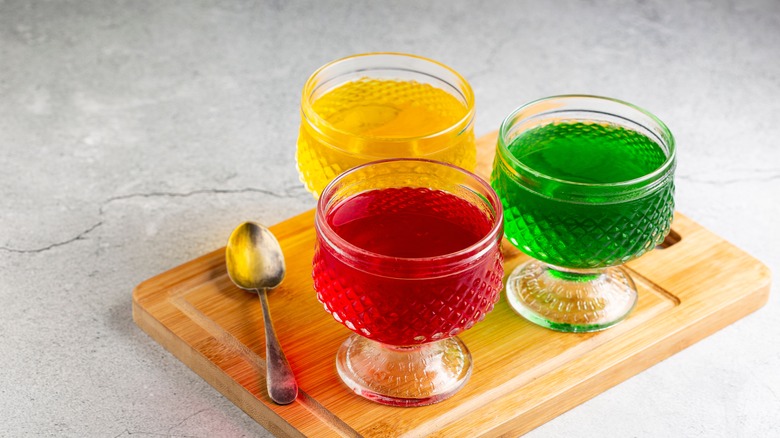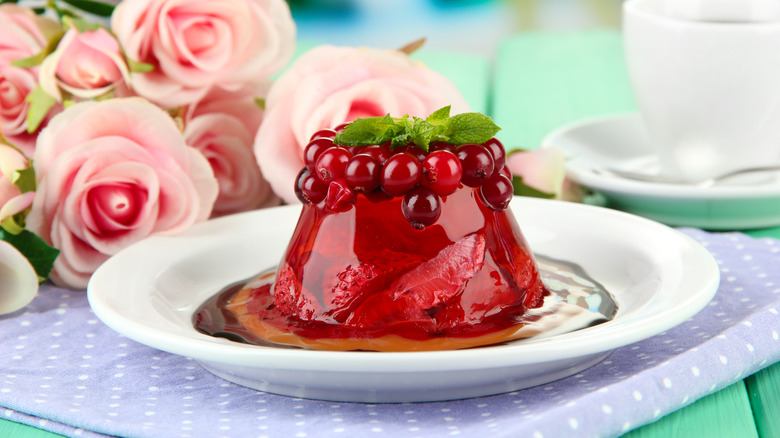How Jacques Pépin Boosts A Classic Bowl Of Jell-O
When budding home cooks want inspiration in the kitchen, they turn to the teachings of the culinary greats. Take Jacques Pépin, for instance, a world-class chef known for penning numerous cookbooks, hosting innumerable cooking shows, and introducing America to French cuisine alongside luminaries like Julia Child (per the about page on Pépin's website). Pépin is also a dedicated teacher and has spent over three decades instructing students at Boston University's Culinary Arts Program.
Fortunately, you don't have to attend his class to glean his immense wisdom and insight. According to Forbes, Pépin's overall goal is to "show people the joy of cooking" — especially for those who may be intimidated by the process. The chef encourages those new to the culinary arts to begin simply by concocting a soup using the ingredients already in the kitchen. Pépin also assuages fears about store-bought ingredients, emphasizing the importance of convenience when it comes to home cooking. In fact, the chef loves one surprising ingredient that is a far cry from gourmet dining.
Not your childhood Jell-O preparation
According to the New York Times, the inspiration for Jell-O was developed by Peter Cooper. Cooper patented a "gelatin dessert" in 1845, which was described as "a transparent concentrated or solidified jelly." However, the true inventor of the Jell-O that we know and love was Pearle Bixby Wait. In 1897, Wait took the basic gelatin recipe and added the vibrant colors and bold fruity flavors that made the dessert such a hit. And the invention was truly a family affair, with May Wait, Pearle's wife, credited as the originator of the name Jell-O. At the time, Wait's creation was available in lemon, raspberry, strawberry, and orange. These days, the product is available in a much wider variety of flavors, including mango, black cherry, lemon-lime, and peach (per the Kraft Heinz Company).
Perhaps surprisingly given his pedigree, Pépin is a proponent of Jell-O, according to Oprah.com. In his 2017 cookbook "A Grandfather's Lessons: In the Kitchen with Shorey," Pépin includes a special family recipe that he developed with his granddaughter Shorey. The pair add a few luxurious ingredients to raspberry Jell-O, including mint, berries, and jelly sauce made from strawberries and currants. Pépin describes the "cold and light" profile of Jell-O as highly pleasing, while also praising its "appealing texture and color." And it appears that Pépin is not alone in his admiration of this fun, springy treat.
Is Jell-O making a comeback?
According to Insider, the popularity of Jell-O and Jell-O-based recipes seemed to reach its zenith in the 1950s. However, tastes have changed drastically over the years, which has led to slipping sales where the gelatin dessert is concerned. Consider that the food brand lost $371 million between 2009 and 2018, with people citing its seemingly artificial nature as a big reason for its decline. The thinking goes that as more people become invested in eating healthy, all-natural foods, the neon color and sugar-laden profile of Jell-O turned a lot of people off.
Despite these setbacks for the brand, Jell-O might just be making a comeback according to Newcity Resto. Learned food historians and world-class restaurants are serving up fruity, gelatin-based treats, much to the delight of people who can't get enough of the stuff. And a search of #jello on Instagram returns numerous posts of people showing off their bouncy creations. One Instagram post from Lynda Sweets shows a beautiful gelatin "cake" brimming with fresh fruits. Another Instagram upload features a throwback to a Molded Prune Salad, which was sourced from a 1952 cookbook. While it may not have reached its previous historic heights, it appears that more and more people are making room for Jell-O these days.


